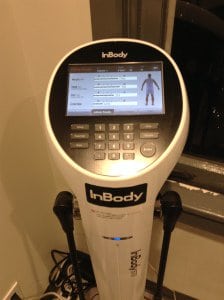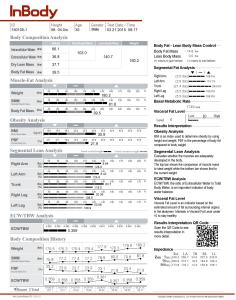Body Fat Accuracy Showdown
If you’re an athlete chances are you probably own or have used a body fat analyzer such as the Omron HBF-306CN (retails for about $40) or the deluxe model HBF-514. These devices use a technology know as Bioelectrical Impedence Analysis (or BIA for short.) Most BIA device circulate a small electrical signal through a person’s body to measure the impedence to the electrical current. This allows the BIA device to determine total body water (TBW). Once the TBW is determined, the BIA device asks the user to input height and weight. Working off assumptions and statistics[1], the machine determines a person’s body fat by factoring in that muscle cells retain lots of water (muscles are thirsty cells), while fat cells are not. So theoretically if person A has a higher TBW than person B, but the same age, height, and weight, than we know person B has a higher fat amount. Working off statistical tables, the machines looks up what fat percentage is given the height, weight, and total body water… viola — the machine spits out a fat percentage.

More Personal Trainer Alexandria Resources
Own a Personal Training Studio or a CrossFit? Interested in learning how the InBody has helped Sand & Steel obtain new clients and improve our programming? Book a phone consultation with Paul and we talk about whether the InBody is a good fit for you.

InBody 570 Technology
If it only worked so well. You may or may not know that most consumer level BIA fat analyzers are not accurate. [2] Pictured on the left are two of the most commonly sold BIA fat analyzers on the home market. We have both at Sand & Steel, and constantly compare them against our InBody 570. What we’ve found is that the Omron devices are reasonably accurate for individuals who are of average body fat and average muscularity. They are incredibly inaccurate [3] for fit individuals or individuals who have 30 plus pounds to lose. While the InBody 570 also uses Bioelectrical Impedence, it has several key differences that makes it much more accurate.
Interested in learning what Macro’s you should be eating based on your InBody Scan? We have a free Macro Nutrient Calculator that you can use to determine your suggested macros.
The InBody uses patented technology that relies on direct measurements and can perform segmental (limbs and trunk) measurements. It uses multiple frequencies of current to provide more accurate measurements. And does not rely on statistical data to determine muscularity of fat percentage. So unlike the home grade device, the InBody 570 is accurate for athletes and overweight individuals.
Book an InBody Scan at Sand & Steel
Why are Tools like the InBody 570 So Important?

For one, if you are training for a sport or competition knowing whether your current regime of fitness and diet is causing improvements in fat reduction and muscle gain is critical. For example, Lori Rose of Onelife Fitness came to Sand & Steel Fitness after completing a vigorous training regime. We had her perform a body fat scan on the both the Omron HBF-514 and the Inbody 570. The difference in her results were staggering to say the least:
| Measurement | InBody 570 | Omron HBF 5-14 | Measured Difference |
| Weight | 135.1 | 135.8 | 1% |
| BMI | 21.2 | 21.2 | 0% |
| Fat (LBS) | 19.8 lbs | 30.96 lbs | 36% |
| Fat Percent | 14.6% | 22.8% | 36% |
| Muscle Mass (LBS) | 64.20 lbs | 47.53 lbs | 35% |
| Muscle Percent | 48% | 35% | 36% |
Lori’s results aren’t atypical though. Today we had a brand new client come in that hadn’t been working out in six months, here’s how her results came out:
| Measurement | InBody 570 | Omron HBF 5-14 | Measured Difference |
| Weight | 133.2 | 133.8 | 0% |
| BMI | 21.5 | 21.6 | 0% |
| Fat (LBS) | 28.4 lbs | 38 lbs | 25% |
| Fat Percent | 21.3% | 28.4% | 25% |
| Muscle Mass (LBS) | 58 lbs | 40 lbs | 42% |
| Muscle Percent | 44% | 31% | 43% |
 The InBody also measures visceral fat… a key indicator of obesity related diseases. In addition, it also measures the ration of extracellular water / total body water, which indicates inflammation levels. It also can detect imbalances between limbs for early detection and prevention of injuries. The test is harmless and painless, and scan and consultation only takes 15 minutes.
The InBody also measures visceral fat… a key indicator of obesity related diseases. In addition, it also measures the ration of extracellular water / total body water, which indicates inflammation levels. It also can detect imbalances between limbs for early detection and prevention of injuries. The test is harmless and painless, and scan and consultation only takes 15 minutes.

Please could you send me a price of the In Body scale.
Please send a price for the in body 570. Thanks,
Hi Michael!
Please get in touch with us via the contact page.
-Paul
How do you know which one was right? Did you do a Dexascan?
Thanks for your question. I don’t represent inBody or Omron. We actually have done about 1000 scans with many comparisons against the dexa, flotation, and bod pod scans. We are working on doing some comparisons against the Fit3d, Styku, and Shapescale. Omron actually makes a number of commercial grade body fat analyzers as well. The one featured in this comparison was a consumer grade model, and honestly you get what you pay for. No real surprise there.
how about tanita brand?
What about Tanita?
Hey, have you noticed if the Inbody 570 body fat percentage value changes depending on if the body is well hydrated compared to dehydrated as it does in traditional BIA devices
Hey I’m just wondering how much an inbody570 scanner costs?
They are very expensive… especially the 570.
You haven’t told us how to interpret values for ECW / TBW analysis. What values indicate inflammation and which do not?
That’s true, I didn’t cover ECW/TBW in this article.